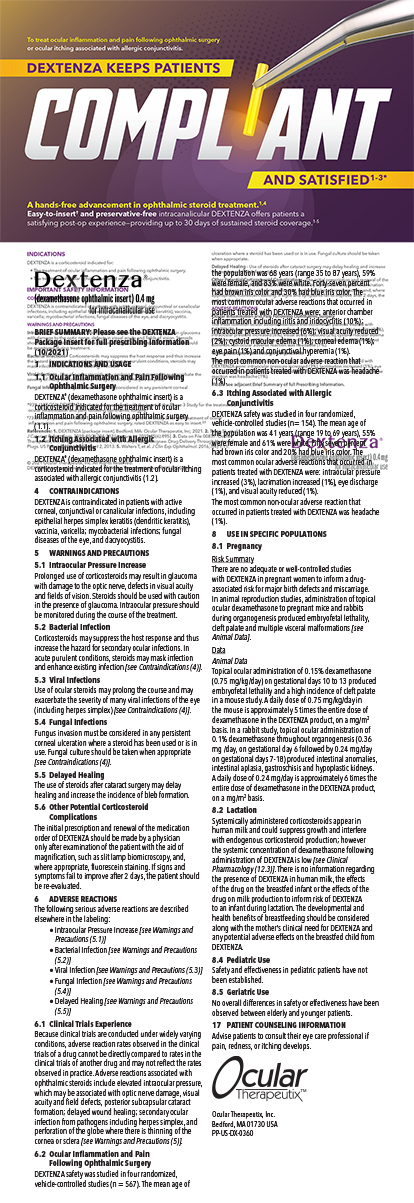Ophthalmologists perform more than 40,000 penetrating keratoplasty (PKP) procedures each year,1 and the visual rehabilitation of these patients can be problematic due to surgically induced anisometropia and astigmatism,2 both of which are common after PKP for keratoconus. Although gas permeable contact lenses are the standard of care, many patients are contact lens intolerant due to environmental factors, poor manual dexterity, functional impairment, or a lack of motivation.
Excimer laser photoablation is an alternative for visual rehabilitation in these patients, but performing LASIK in post-PKP keratoconus patients raises concern, because the surgeon creates the lamellar flap in an ectatic recipient bed. For a keratoconus patient with pre-existing corneal ectasia sufficient to have required a PKP, LASIK may increase his risk of developing corneal ectasia and recurrent keratoconus in the graft.
PRK after PKP commonly causes corneal haze (Figure 1), thereby limiting the effectiveness of the procedure.3,4 Investigators have demonstrated, however, that the use of mitomycin C (MMC) can effectively prevent haze after PRK.5 We recently investigated the safety and efficacy of topical MMC combined with PRK for treating post-PKP refractive errors in keratoconus patients.
METHODOLOGY
All subjects had undergone PKP for keratoconus, were contact lens intolerant, and had had their sutures removed at least 3 months prior to study enrollment. The study included eight eyes of seven patients with a mean age of 36 years. Seven of the eyes were myopic, and one was hyperopic. Before undergoing PRK, the UCVAs were 20/200 in one eye, 20/400 in two eyes, and counts fingers in five eyes. The preoperative BCVAs with spectacles were 20/20 in one eye, 20/25 in five eyes, 20/30 in one eye, and 20/40 in one eye. The mean preoperative refraction of the seven myopic eyes was -5.96 ±3.02 D (spherical equivalent) and 3.86 ±2.11 D (cylinder). Regarding the single hyperopic eye, the manifest refraction was +7.00 -4.75 X 125 = 20/25, and the spherical equivalent was +4.63 D preoperatively.
Dr. Donnenfeld performed all the surgical procedures using either the STAR S4 (VISX, Inc., Santa Clara, CA) or the Technolas (Bausch & Lomb, Rochester, NY) excimer laser. After PRK photoablation, he applied 0.02% MMC to the corneal stromal bed for 2 minutes with a Merocel sponge (Medtronic Ophthalmics, Jacksonville, FL) (Figure 2).
All subjects wore bandage contact lenses until their epithelia closed. We prescribed ofloxacin 0.3% q.i.d. for 5 days; prednisolone acetate 1.0% q.i.d. for 2 weeks, t.i.d. for the next 2 weeks, b.i.d. for another 2 weeks, and then q.d. for 2 weeks; and ketorolac tromethamine 0.5% q.i.d. for 2 days. We followed the patients daily until their epithelia closed and at 1 week, 1 month, 3 months, and 6 months postoperatively.
RESULTS
All patients had a postoperative BSCVA of between 20/20 and 20/30. The mean refraction of seven myopic eyes at 6 months was -1.00 ±0.72 D (spherical equivalent) and 0.60 ±0.52 D (cylinder) at 6 months. Regarding the single hyperopic eye, the manifest refraction was +0.25 -0.75 X 165 = 20/25, and the spherical equivalent was -0.13 D at 3 months postoperatively. All patients were visually rehabilitated with spectacles, and two did not require any corrections. No patient needed a contact lens.
All patients maintained corneal clarity, lost no lines of BSCVA, and developed no corneal haze. There were no adverse reactions to the corneal button, scarring, or healing abnormalities.
CONCLUSION
Based on the results of our study, PRK with adjunctive MMC appears to safely treat refractive errors after PKP for keratoconus and effectively prevent postoperative corneal haze. Nevertheless, long-term follow-up and a controlled trial of PRK with adjunctive MMC after PKP compared with LASIK after PKP for keratoconus are needed.
Eric D. Donnenfeld, MD, is a partner at Ophthalmic Consultants of Long Island in New York. He holds no financial interest in the products mentioned herein. Dr. Donnenfeld may be reached at (516) 766-2519; eddoph@aol.com.
1. Eye Bank Association of America. Statistical report. Available at: http://www.restoresight.org/general/publications.htm. Accessed September 4, 2003.
2. Brooks SE, Johnson D, Fischer N. Anisometropia and binocularity. Ophthalmology. 1996;103:1139-1143.
3. Bilgihan K, Ozdek SC, Akata F, Hasanreisoglu B. Photorefractive keratectomy for post-penetrating keratoplasty myopia and astigmatism. J Cataract Refract Surg. 2000;26:1590-1595.
4. Bansal AK. Photoastigmatic refractive keratectomy for correction of astigmatism after keratoplasty. J Refract Surg. 1999;15:2(suppl):S243-245.
5. Majmudar PA, Forstot SL, Dennis RF, et al. Topical mitomycin-C for subepithelial fibrosis after refractive corneal surgery. Ophthalmology. 2000;107:89-94.


